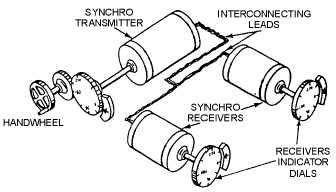1-3
small electrical motor in size and appearance and operates like a variable transformer. The synchro, like
the transformer, uses the principle of electromagnetic induction.
Figure 1-1.—Phantom view of a synchro.
Synchros are used primarily for the rapid and accurate transmission of information between
equipment and stations. Examples of such information are changes in course, speed, and range of targets
or missiles; angular displacement (position) of the ship's rudder; and changes in the speed and depth of
torpedoes. This information must be transmitted quickly and accurately. Synchros can provide this speed
and accuracy. They are reliable, adaptable, and compact. Figure 1-2 shows a simple synchro system that
can be used to transmit different as of data or information In this system, a single synchro transmitter
furnishes information to two synchro receivers located in distant spaces. Operators put information into
the system by turning the handwheel. As the handwheel turns, its attached gear rotates the transmitter
shaft (which has a dial attached to indicate the value of the transmitted information). As the synchro
transmitter shaft turns, it converts the mechanical input into an electrical signal, which is sent through
interconnecting wiring to the two synchro receivers. The receiver shafts rotate in response to the electrical
signal from the transmitter. When these shafts turn, the dials attached to the shafts indicate the transmitted
information.
Figure 1-2.—Data transfer with synchros.



